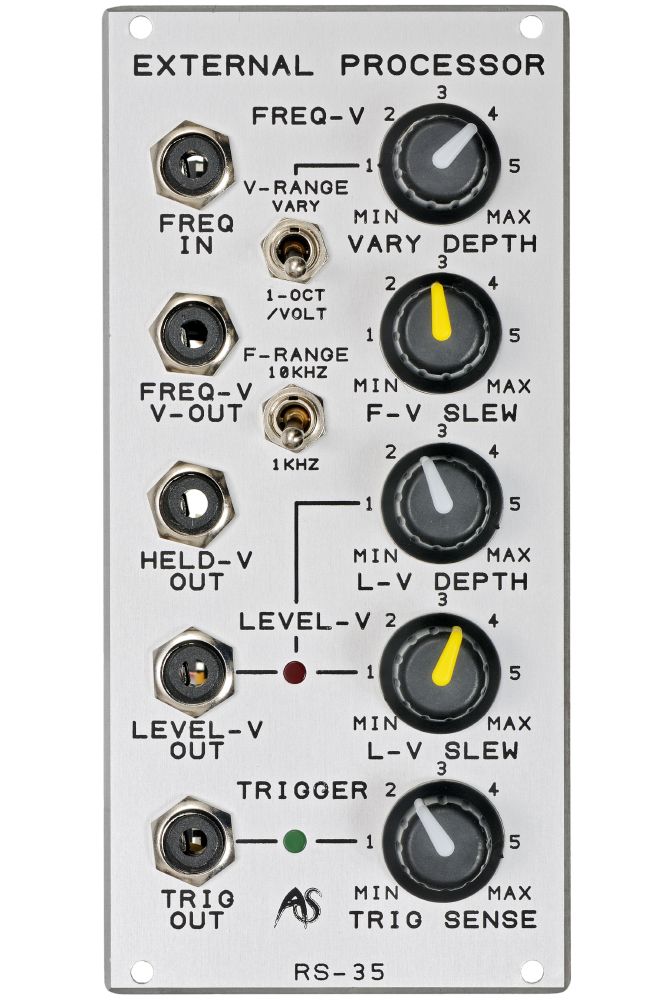Analogue Systems
RS-35
External Processor
The RS-35 contains three circuits for extracting control voltages from an audio signal: frequency-to-voltage generator, level-to-voltage generator and a trigger generator.
Frequency-to-voltage (FREQ-V): This circuit of the RS-35 circuitry is also known as "pitch-to-voltage converter". It analyzes an audio signal and creates a frequency dependent control voltage. The higher the frequency the higher the voltage is. the input accepts signals of ±10V. The V-Slew control can smoothen abrupt changes in the output signal and thus create a portamento up to 2 seconds length.
The "V-range" switch determines the voltage range at the output. In the 1V/oct mode it will generate a control voltage with !V/osctave characteristic and a range of -4V to 3V. In VARY mode the "vary depth" control sets the onversion range from 0V to 0.5V/oct. In this mode the voltage range at the output is -10V to 6V.
The switch "F-Range"sets frequency range to be analyzed. "kHz" converts frequencies from 20Hz to 1,2kHz with a accuracy better than 1%. "10kHz" converts frequencies from "100Hz to 10kHz with an accuracy better than 2%.
HELD-V: Without an input signal the voltage will not drop back to zero but instead it will be held until the next trigger is generated by the according section (see below). Accuracy is 5% in low bass (20Hz to 100 Hz) and 1% in 100Hz - 1.2Hz range. In the 10kHz mode of the FREQ-V circuit the accuracy is constantly 2% over the whole 10kHz range.
Level to voltage (LEVEL-V): This unit is commonly known as "envelope follower". It produces a control voltage depending on the amplitude of the audio signal. A LED shows activity. Abrupt steps in the signal can be smoothened with the LV-SLEW contol (max. 1s). LV-LEVEL controls output level from 0V to 10V.
TRIGGER: A 5V pulse wave is generated from the audio signal in the range betwenn 1Hz and 10kHz. The circuit´s sensitivity is adjusted with the TRIG-SENSE control.
In use :
The RS-35 is a further development of the RS-30, with greater flexibility and accuracy in the frequency-to-voltage converter and envelope follower (level-to-voltage) sections, and an additional frequency (trigger) extractor.
The converter works most effectively when the presented signal is pure and monophonic, so you may find it useful to insert a band-pass filter into the signal chain immediately before its input. If tuned to the frequency range of the instrument or voice being converted, this will attenuate upper harmonics and eliminate extraneous signals that may cause the RS-35 to track less accurately.
FREQUENCY TO VOLTAGE CONVERSION
The RS-35 F / V converter accepts an audio signal at its input, analyses its pitch and generates a pitch CV.
-
FREQ IN:
The input accepts any audio signal in the range ±10V. Two frequency-to-voltage conversion modes are provided:
1OCT/VOLT: The RS-35 produces CVs conforming to the 1V/Oct standard. The maximum output voltage lies in the range -4V to +3V.
VARY: Conversion ranges from approximately ∞V/Oct (no response at MIN) to 0.5V/Oct (MAX) as determined by the position of the VARY DEPTH knob. The maximum output voltage lies in the range -10V to +6V.
-
F-RANGE:
Two frequency modes are provided:
1kHz: The RS-35 converts signals in the range 20Hz - 1.2kHz. The accuracy of the output CV is better than 1%.
10kHz: The RS-35 converts signals in the range 100Hz - 10kHz. The accuracy of the output CV is better than 2%.
-
F-V SLEW:
The SLEW control prevents rapid changes in the CV derived from the input. At its maximum, the slew rate is approximately 2s, providing smooth transitions (portamento) between voltages.
-
FREQ-V V -OUT:
The converter provides a single output with a maximum range -10V to +6V. When no signal is present at the input, the output voltage drops to the minimum determined by the conversion mode selected and (if appropriate) VARY DEPTH. This means that a voltage in the range 0V to -6V is generated at the output.
-
HELD-V OUT:
At this output, no drop in the CV occurs when no input signal is present, and the output CV is held constant between instances of Trigger activity (see below). The accuracy at the HELD-V OUT is better than 1% between 100HZ and 1.2kHz, but will drop toward 5% in the deep bass (20Hz to 100Hz). The accuracy is better than 2% across the whole of the 10kHz range.
LEVEL TO VOLTAGE CONVERSION
The RS-35's envelope follower, which incorporates a level control and a slew limiter, generates a CV corresponding to the average amplitude of the signal presented to the FREQ IN input.
-
L-V LEVEL:
At its maximum anticlockwise setting, the LEVEL voltage is fully attenuated. As you turn the control clockwise, the gain increases and, at MAX, a voltage in excess of +10V can be obtained.
The red LED provides visual confirmation of the level-to-voltage activity. If this is not lit, there is no conversion, and you should increase the L-V DEPTH.
-
L-V SLEW:
Slew prevents rapid changes in the signal derived from the input. At its maximum, the slew rate is approximately 1s.
-
LEVEL-V OUT:
Provides an output in the range 0V to +10V
TRIGGER GENERATION
A pulse wave is generated at the frequency of the input signal within the range 1Hz to 10kHz. If at a suitably low frequency, you can use this to clock sequencers, to trigger contour generators, and so on.
At higher frequencies, use an RS-280 clock divider to extract suitable triggers
-
TRIG SENSE:
The Sense (sensitivity) determines the amplitude level of the triggers generated.
-
TRIG OUT:
The trigger output is nominally a +5V pulse.
The green LED provides visual confirmation of the trigger generator's activity. If this is not lit, the trigger level will be too low to drive the inputs of other modules, and you should increase the TRIG SENSE
